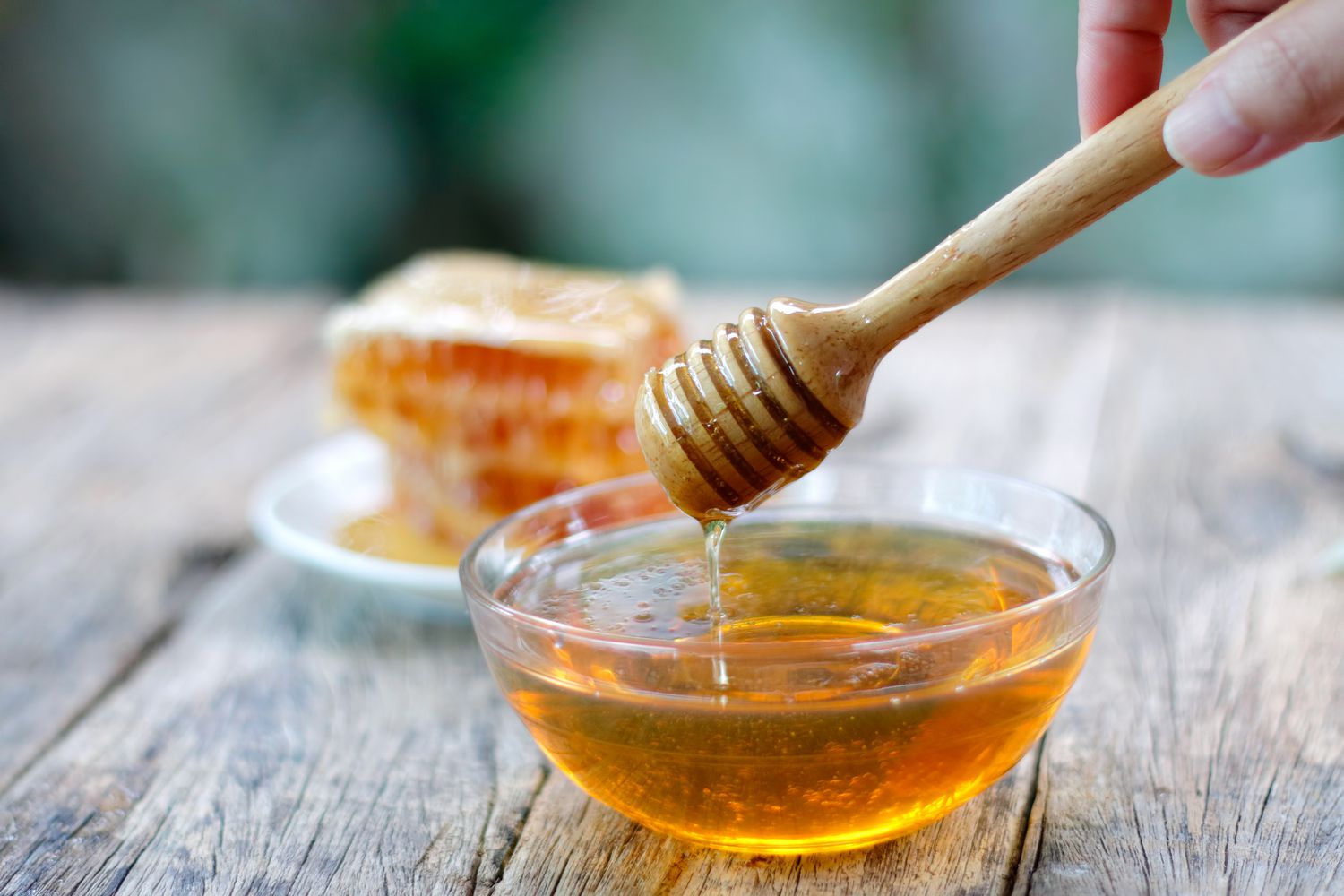3 Best Substitutes for Honey

Rapeepong Puttakumwong / Getty Images
Honey is often revered as a nutritious food with a variety of health benefits. The viscous liquid adds a sweet flavor to warm drinks like hot tea and coffee. It also complements foods like nuts, fruits, cheeses, and more. You can drizzle honey on foods and drinks as well as stir it into salad dressings, sauces, and marinades and cook it in sweet and savory dishes.
When eaten in moderation, honey can be part of a balanced meal plan. However, its nutrition profile shows that honey is a concentrated source of sugar. There are nutritional, health-related, and ethical reasons that someone might want to avoid honey.
Why Use an Alternative?
There are many different reasons why someone might want a substitute for honey. For instance, some people cannot eat honey because of allergies or dietary restrictions.
For instance, vegans and those with ethical concerns about bee populations may avoid honey and products containing honey. If a recipe calls for honey, vegans will need to use one of the following substitutes as an alternative or omit it altogether.
Dietary allergies are another common reason to avoid certain foods and ingredients and honey is no exception. Although the incidence of allergy to honey in the general population is unknown, it’s estimated to be around 0.001%. If you have allergies to honey or suspect you may be allergic to honey, it may be worth seeking safe substitutes.
Many of the affordable store-bought honey products are adulterated, artificial, and heavily processed so they no longer resemble pure honey and possess the same qualities. Pure honey can be expensive and difficult to find, so some may prefer to use a more affordable, accessible alternative, especially because certain types of honey can be pricey like Manuka honey.
Honey also can contain the bacteria that causes infant botulism. Healthcare providers indicate that children younger than 12 months old should not consume honey. And finally, honey is a concentrated source of sugar. Due to this, people with diabetes or those following a low-sugar diet may seek more suitable alternatives.
Honey Nutrition
This nutrition information for 1 tablespoon (21 grams) of honey is provided by the USDA.
- Calories: 63.8
- Fat: 0g
- Sodium: 0.84mg
- Carbohydrates: 17.3g
- Fiber: 0.042g
- Sugars: 17.2g
- Protein: 0.063g
Foods like honey that are consumed in small amounts and as additions to other foods instead of on their own are not a significant source of micronutrients. However, the sugar content adds up quickly. The 2020-2025 Dietary Guidelines for Americans recommend that no more than 10% of total daily calories come from added sugars.
Popular Substitutes
Honey substitutes typically replace the sweet flavors that honey adds to foods and drinks. These honey substitutes can be used at a one-to-one ratio to replace honey in recipes.
Molasses
Molasses is made during the sugar-making process. The result is a thick, dark syrup that can be used to sweeten foods, especially in baking.
Because molasses has a stronger flavor than honey, it can alter the flavor of the recipe. For the most similar flavor profile, opt for light molasses as a honey alternative.
Compared to honey, contains about 58 calories per serving as compared to honey which is 63 and 14.9 grams of sugar verse 17.2 grams. Because it is a liquid, replace honey with equal parts molasses.
Maple Syrup
Maple syrup has a distinct flavor. Because it is sweet and gooey like honey, it is a great honey substitute for baking and cooking. Maple syrup also has less sugar than honey with 12.1 grams of sugar while honey has 17.2 grams.
Nutritionally, maple syrup also is a solid alternative when it comes to micronutrients and contains riboflavin and manganese. When replacing honey with maple syrup, use a one-to-one ratio for best results.
Agave Nectar
If you are looking to replace the drizzle of honey in your tea or coffee, agave nectar makes for a great substitution. It has a mild flavor so it doesn’t dominate your foods or drinks as other honey alternatives might.
Agave is nutritionally similar to honey in terms of macronutrients, too. The caloric, carbohydrate, and sugar content in agave is almost equivalent to that in honey. It also contains small amounts of micronutrients but these amounts usually are not significant. Agave also has a similar consistency to honey, making it a suitable one-to-one swap.
A Word From Verywell
Finding the perfect replacement for your recipe or intended use can be tricky. In the case of honey, the best substitute is sweet and has a similar thick, gooey consistency.
Fortunately, there are a number of solid replacements that can be utilized instead. Molasses, maple syrup, and agave nectar are all excellent alternatives to honey providing a similar flavor and nutritional profile.
Aguiar R, Duarte FC, Mendes A, Bartolomé B, Barbosa MP. Anaphylaxis caused by honey: a case report. Asia Pac Allergy. 2017;7(1):48-50. doi:10.5415/apallergy.2017.7.1.48
Centers for Disease Control and Prevention. Many cases of botulism are preventable.
USDA, FoodData Central. Honey.
USDA, FoodData Central. Molasses.
USDA, FoodData Central. Syrups, maple.
USDA, FoodData Central. Sweetener, syrup, agave.
:max_bytes(150000):strip_icc()/Lacey-Bourassa-1000-7e7238164b654c89aa64c712c0b0b194.jpg)
:max_bytes(150000):strip_icc()/barbie-e9739b06fba546f7be0798a3da80e2f6.jpg)
:max_bytes(150000):strip_icc()/Lacey-Bourassa-1000-7e7238164b654c89aa64c712c0b0b194.jpg)
:max_bytes(150000):strip_icc()/GettyImages-1320686469-23c386e2f46c49de9052baca3cdee5fe.jpg)
:max_bytes(150000):strip_icc()/GettyImages-839573508-ed442e04296d4f538ff1028f813e3973.jpeg)
:max_bytes(150000):strip_icc()/7-best-sugar-alternatives-of-2023-tout-06599f1d6c994bb09bbc1ae66b3a5267.jpg)
:max_bytes(150000):strip_icc()/GettyImages-1255787221-3589d5984cb84925983714fb522608c0.jpg)
:max_bytes(150000):strip_icc()/GettyImages-1053780884-adf9e531178746eead76ccc0c782face.jpeg)
:max_bytes(150000):strip_icc()/GettyImages-1281196664-93c5b7ecb478432293f25f2fa3f617e5.jpg)
:max_bytes(150000):strip_icc()/GettyImages-1316835598-2779d98046b64081ba2157849bae3e56.jpg)
:max_bytes(150000):strip_icc()/best-green-teas-5115813_Fit-80af7f827cec4637b5cc18fa1bd1800a.jpg)
:max_bytes(150000):strip_icc()/GettyImages-455450237-623b32c1faa441c694ddc30054aacc63.jpg)
:max_bytes(150000):strip_icc()/GettyImages-947886300-a9def3f522ab494cafcbc4e126dd4621.jpeg)
:max_bytes(150000):strip_icc()/agave-nectar_annotated-40ad1b2d6299425e81c92449b59a1768.jpg)
:max_bytes(150000):strip_icc()/GettyImages-1163934972-40bd91ee655642838216922308eb6b56.jpeg)
:max_bytes(150000):strip_icc()/GettyImages-953147476-cfe1bc40f0264da3ada00042325f0d39.jpg)
:max_bytes(150000):strip_icc()/GettyImages-155359156-51b46a1cb31e4214835fa8fc3d6aed11.jpg)
:max_bytes(150000):strip_icc()/GettyImages-177746753-b3dc71996812470eba1a323f89cde3ef.jpg)
:max_bytes(150000):strip_icc()/agave-nectar-171fb8ce5d6346588f433d341405fe0d.jpg)